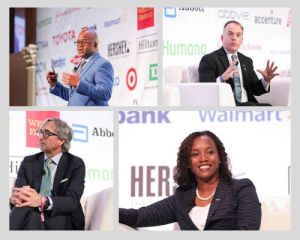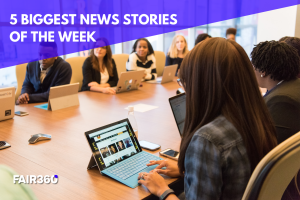On Oct. 2 at Fair360, formerly DiversityInc’s annual Women of Color and Their Allies event, Natasha Miller-Williams, SVP of Diversity and Inclusion at Nielsen and Stefani Raggio, Vice President of Human Resource Operations for North America Hilton, talked about intersectionality and how to navigate your career.
Intersectionality is when the overlap of race, gender, sexuality and/or class can contribute to different types of systemic oppression and discrimination. Miller-Williams told attendees she has personally experienced discrimination and assumptions that as a Black woman, she is not a leader at the company.
Part of it is because only 1-2% of corporate leadership roles are held by Black women.
“I’ve been very motivated to move into senior leadership for a lot of different reasons: to change that really sad, pitiful number, to change mindsets, to make sure that any time one of us is going to a conference, someone doesn’t sit down next to us and ask a question like: ‘Who do you report to?” Miller-Williams said.
The panel then spoke about navigating your career as a woman of color and what advice Miller-Williams and Raggio would give other females.
“Declare what your vision is,” Raggio said. “Just declare it. If it’s declared in your mind, that just sets the stage for building those relationships with those mentors and sponsors inside your organization, outside your organization, finding those advocates, finding those allies. But you have to be thinking about it here before you can actually act on it.”
Miller-Williams spoke about a study finding that Black women are more likely to be more overlooked than Black men and white men and women. In order to combat that, she talked about her strategy to navigate her career while keeping herself visible in the company.
“One of the things that I have been really mindful of, knowing that that is likely to happen, is what are the ways that I can create hyper-visibility for myself and at my organization?” Miller-Williams said. “For me, it’s been about putting myself into probably what’s been considered risky roles, like the organization’s biggest bets. Those projects or those initiatives that I know the company itself has a lot of eyes on, the can’t-miss opportunities, the ones that put me closest to senior leadership, including the CEO, who I work with very closely now.”
For women of color, on top of the day job, there is challenging emotional work that has to be done in order to manage intersectionality, the career and increasing visibility against the odds. The panelists discussed some of the things that they do to keep their energy up. Miller-Williams talked about finding the balance between delivering twice as much as anyone else while also having a self-care plan.
“There’s nothing wrong with delivering two times as much as someone else, and that’s been a bit of a personal mantra for me to make sure that I am overdelivering,” Miller-Williams said. “But [a self-care plan] becomes a way to make sure that I am managing my energy, and also my time, against what matters most for me at home and at work.”
In the workforce, women of color often have to make difficult choices concerning the nature of their identity and what part of themselves to emphasize during the day. Raggio spoke about her difficulties working in industries outside of hospitality that were not used to and supportive of a diverse workforce and did not make inclusion and intersectionality a priority.
“Is this the place I want to be? I’m not sensing as much diversity as I thought,” Raggio said about her experiences outside of hospitality. “I’m looking at programs. Was there equity in the programs? I wasn’t convinced that I was seeing that. I came back to hospitality because it’s where I felt more comfortable, so I had to make that tough call, and that tough call doesn’t come easy.”

















